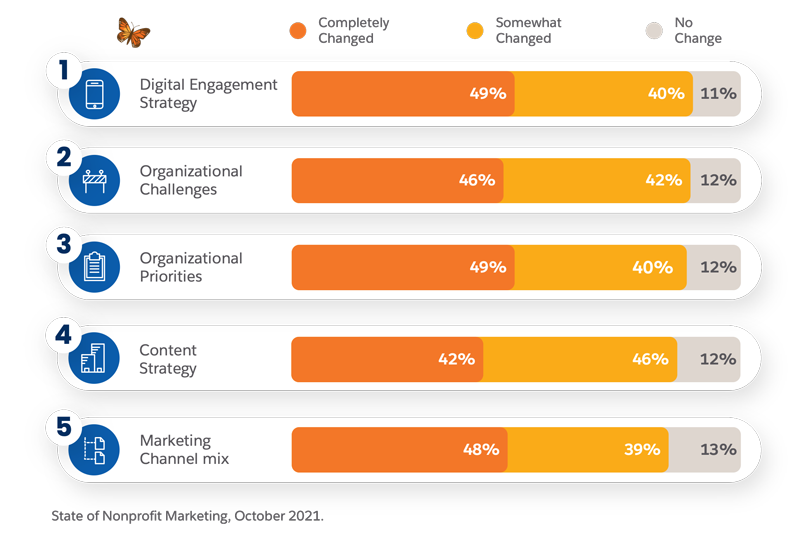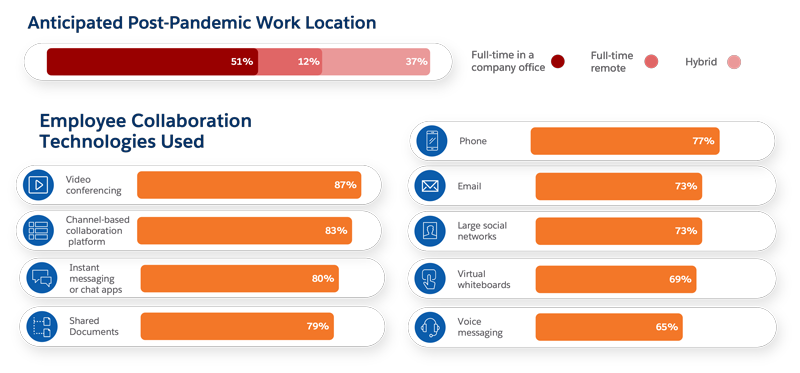We are excited to release the 2021 State of Nonprofit Marketing Report in partnership with the Salesforce.com research team. This report contains responses that have been analyzed from 390 nonprofit marketers around the world as part of a broader survey of 8,200 marketers, including corporations and nonprofit organizations.
People have shifted online in record numbers throughout the pandemic, which has resulted in digital overload and fatigue for many of us. And while technology and channels keep expanding, regulations typically constrict marketers. Meanwhile, the nonprofit sector is overcoming challenges faced by increasing disasters and community needs, combined with new opportunities for tapping into people’s passion to create change.
It’s clear that the pandemic altered many aspects of how nonprofits operate. Brian Tumpowsky, head of digital technology at UNICEF USA, discussed these changes in a recent interview.
“We realized that people were going to be connecting with us virtually more and more. As the data about those interactions became more voluminous, we wanted to make it centralized and leverageable. These issues were already at play before the pandemic, but it made the need more urgent.”
Given the port to digital, it’s no surprise that innovation was the only item that showed up as a top priority and challenge this year.

You can use the newly-released State of Nonprofit Marketing Report to gain insights into how your nonprofit peers are shifting strategy, using data, and leveraging technology to drive a better experience overall. Here are the report’s five key takeaways, with supporting statistics.
Marketers are shifting during constantly changing times
The world has been rocked by a pandemic, impacting people’s behaviors and priorities, along with how we work with greater agility. Most marketers shifted their strategies, from the channels they use to how they define success. In fact, 89% of nonprofit marketers have already changed their digital engagement strategy in the past year.
At the same time, marketers realize that the people we are trying to reach are stretched thin, and they are competing for attention from other nonprofits and consumer media on the web. This was clear in the report, with 84% of CMOs saying that their marketing must transform in order to be competitive.

Marketing steps up to today’s digital expectations
Marketers have tried to stay close with their communities, with 83% of nonprofit marketers saying people’s preferences are changing their digital strategies and 88% having made changes in their content strategy. To keep people’s attention, the most popular tactic by far is video.
However, the tools that most respondents planned to use more frequently were social GIFs and memes, highly personal user-generated content, and influencer marketing for more authentic content. These growth areas all perform well on social, but so do traditional channels like email. In each of the three years we have tracked this report, marketers report improvement in their coordination across channels to meet their constituents where they are.

But how do your constituents feel about your content and communications? To answer that question, we supplemented this research project with a survey of over 4,900 donors, volunteers, and beneficiaries worldwide. When responding to the statement that “The communications I received from the nonprofit were personalized for me”, only 33.6% agree, and 6.4% strongly agree.
There were also large groups of people who felt that they were asked to give too often, versus not enough, showing timing is also a key ingredient. Although each individual’s communication preferences are different, the highest preference by far was still email. Most nonprofits have agreed their biggest area for improvement is to make communications feel more personal and timely.
We are excited to release the 2021 State of Nonprofit Marketing Report in partnership with the Salesforce.com research team. This report contains responses that have been analyzed from 390 nonprofit marketers around the world as part of a broader survey of 8,200 marketers, including corporations and nonprofit organizations.
Collaboration drives the “market from anywhere” era
Many staff outside of marketing are collaborating on campaigns with you — and communicating on behalf of your organization — all while working more remotely than ever before. No longer tied to offices, a distributed workforce is reevaluating how they engage not only constituents, but each other. This was shown in the data, where 75% of marketers say the pandemic has permanently shifted how they collaborate and communicate at work, and 77% have already adopted new work collaboration technology to help them do so.
And while there’s been a shift in collaboration, it’s imperative that your systems and data are connected to the technology you use to collaborate and communicate. For many that’s not the case, as 68% of nonprofit marketers say it’s harder to collaborate now than before the pandemic. Here’s where people expect to work post-pandemic, and the collaborative technology they use.

Marketers strive to be more data-driven
Like humans need water, marketing needs data to be effective in digital marketing and offline marketing. Data empowers marketers to deliver trusted, personalized engagement. Although we are moving towards a more data-driven approach, nonprofit marketers shared ongoing struggles.
Managing data in a way that is clean, relatable, and secure is becoming more complex. Seventy-one percent of nonprofit marketers say their engagement is data-driven, however only 33% of nonprofit marketers are completely satisfied with their ability to use data to create more relevant experiences.
Data is growing at a rapid rate also, with nonprofits marketers expecting an average of four new data sources by 2022, whereas corporations only expect three. Additionally, confidence in data depends on the source of the data, and the size of the nonprofit.

Metrics and KPIs continue to evolve
In addition to using it to personalize engagement, at a strategic level, data rolls up to key performance indicators and metrics. In times of change, measurement allows everyone to understand what is working.
As a nonprofit marketing team’s work becomes more strategic and agile, staff are reevaluating what successful marketing looks like. Three quarters of nonprofit marketers have changed or reprioritized their success metrics during the pandemic, and only 37% of nonprofit marketers are completely satisfied with the timeliness of their data. If metrics aren’t easily accessible, gaining insight from them probably won’t happen as often as it should.
That’s enough data for now. My major learning is that we each need to have our own operating model for how we approach our marketing strategy, and that the foundational elements of technology and data are critical to everything we do.
Learn more by downloading the State of Marketing report.
































